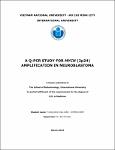| dc.contributor.author | Diem, Truong Dinh Kieu | |
| dc.date.accessioned | 2017-04-24T19:04:56Z | |
| dc.date.accessioned | 2018-06-04T03:03:53Z | |
| dc.date.available | 2017-04-24T19:04:56Z | |
| dc.date.available | 2018-06-04T03:03:53Z | |
| dc.date.issued | 2015 | |
| dc.identifier.other | 022002146 | |
| dc.identifier.uri | http://10.8.20.7:8080/xmlui/handle/123456789/1850 | |
| dc.description.abstract | Neuroblastoma (NB) is a primitive neuronal tumor of sympathetic nervous tumor. It is the
most common solid tumor of childhood that arising from neural crest cells during
development. Over the past decade, advances in the clinical staging of NB have improved
risk stratification. Of note, the high-risk Neuroblastoma patient is often targeted to high
dose myeloablative therapy with allogeneic or autologous bone marrow transplantation. The
high risk NB are reported with high frequency of alterations based on the most significantly
known genes, MYCN (2p24) amplification, which is detected by fluorescence in situ
hybridization (FISH) analyses. Recently, quantitative PCR has proven to be a good
alternative for the detection of gene copy number changes. Changes in copy number of
genes contribute to the pathogenesis of various genetic disorders and cancer. The status of
a gene has not only diagnostic value but sometimes directs treatment stratification. This
molecular diagnosis is important to improve the changes of different genetic events in high
risk NB stage IV.
Key words: Neuroblastoma, MYCN, Real-time PCR | en_US |
| dc.description.sponsorship | Dr. Bui Chi Bao | en_US |
| dc.language.iso | en_US | en_US |
| dc.publisher | HCMC - International University | en_US |
| dc.relation.ispartofseries | ;022002146 | |
| dc.subject | Neuronal -- Neuroblastoma | en_US |
| dc.title | A Q-PCR study for mycn (2p24) amplification in neuroblastoma | en_US |
| dc.type | Thesis | en_US |


